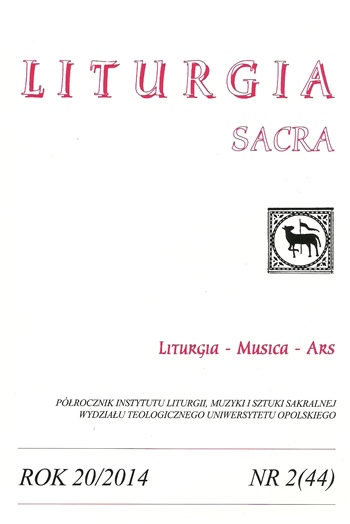Zarys pedagogii nadziei w obrzędach pogrzebu dorosłych
The Pedagogy of Hope in the Rite of Funeral of Adults — an Outline
Author(s): Wojciech MalesaSubject(s): Christian Theology and Religion, Theology and Religion
Published by: Uniwersytet Opolski
Keywords: funeral ceremony; Second Vatican Council; liturgical signs;
Summary/Abstract: The funeral ceremony, prepared in compliance with the recommendation of the Second Vatican Council, highlights clearly the Paschal dimension of death. The emphasis that is contained in the content of prayers and liturgical signs constitutes a sort of religious instruction addressed to the participants of the liturgy. The privileged spot is occupied by the dead, encircled by the close persons, praying with the hope for salvation. The death of an individual incorporates him/her into the Paschal Mystery, considered a transition into another form of life. The first event that follows it, is an encounter of a human being with God, throughout which, standing before God, the individual needs to reflect honestly about himself/herself, the individual confronts the true moral value of his/her deeds. Yet this encounter is joyous as it establishes another stage of the relationship with the Almighty. For the living ones, the death of the close person is, however, related to grief. In the funeral prayers, the Church consoles them extensively and indicates a paschal hope of Resurrection and a meeting with the dead. It is based on the belief of redemption made by the Christ, owing to which everybody has an opportunity for salvation. In the prayers there are many mentions about Christ’s Sacrifice, present particularly in the sacraments and, in this context, they ask for forgiveness for the dead that will allow him/her into the world of everlasting happiness — joy, light, and peace. The texts of the prayers comprised in the liturgy book present a coherent concept of redemption. They indicate that it results from Christ’s Paschal Mystery, is related to the eternal life and Resurrection, is meant to stay among the Holy Trinity, in the communion of the saints, where they will find happiness and be free from any pain. In terms of death, the Church leaves man on his own, yet it becomes more involved in praying for him.
Journal: Liturgia Sacra
- Issue Year: XX/2014
- Issue No: 44
- Page Range: 417-425
- Page Count: 9
- Language: Polish
- Content File-PDF

